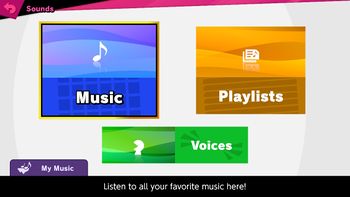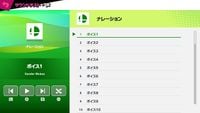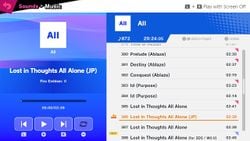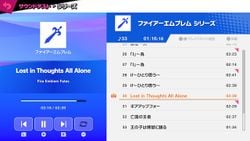Sound Test

Sound Test is an option that appears in the Super Smash Bros. games.
Overview
The Sound Test allows the player to listen to most of the music and sounds in the game. Players can listen to the voices of characters, stage music, and listen to other variety of sounds. If the player leaves the Sound Test while a song is playing and goes back through the menus, the song will still play until it is overridden by another piece of music, or until the player enters the character select screen.
Super Smash Bros.
Sound Test was introduced in this seminal entry, and laid the foundation for all other sound test options in future games. The Sound Test is unlocked by completing Break the Targets and Board the Platforms with all 12 characters. The option can then be accessed through Data Mode. The sounds are split into 3 sections: MUSIC, SOUND, and VOICE. The music and sounds in these sections do not have specific categories, they are instead marked with a number and the player needs to memorize which number goes with which track in which section. The Fighter Select music is not in sound test for unknown reasons.
Super Smash Bros. Melee
Sound Test returns in Melee, with some small changes. The option is unlocked by unlocking all playable Stages. The option can be accessed through Data Mode. Unlike SSB, the name of the track is now displayed on the screen instead of just a number. This was also the first time tracks were organized by series and fighter, making said tracks much easier to find. This method has been kept for every future installment. Generic, menu, and stage sounds each have a singular category, as do enemies and Poké Ball Pokémon. Sheik is grouped under Zelda's category. Kirby's copy ability voice clips are unlocked after unlocking every base game fighter. The Giga Bowser music in Melee is not in sound test for unknown reasons.
Super Smash Bros. Brawl
Sound test once again returns in Brawl, and once again received changes. The option is now available from the start without unlocking, though songs and sounds remain hidden until their source character, stage, or CD is unlocked. It can be accessed through either Data or Option Mode. Brawl introduces the feature of adding a source game to every song and indicating if it was ripped from another game or remixed specifically for the Smash franchise. The Cruel Brawl theme along with the winter version of Obstacle Course is not in sound test for unknown reasons.
Super Smash Bros. 4
Sound test, now simply titled Sounds, is again unlocked from the start with some tracks hidden until unlocked. It is located in the Vault and can also be accessed via the sound settings in Options. Sounds is unique among the series in that one version has unique the other version does not have and vice versa. The 3DS version was the first to drop sound effects and victory themes, leaving only music and voices viewable. This version was also the first to introduce alternate costumes serving as alternate characters (such as the Koopalings or female Robin) feature separate sections from the default ones. Music tracks are indicated by a blue background, while voice clips are in green. The number system is done away entirely and instead has a list of tracks similar in presentation to an iPod interface . The songs do not loop indefinitely anymore and instead fade out after a certain amount of time. The music selection emphasizes handheld games as a reference to the fact that the 3DS is a handheld console. The copyright owner and/or arrangement supervisor of each music track is now viewable in the info section. The main feature of the 3DS version is that the option exists to keep music playing even when the system is in sleep mode. Pressing the L and R buttons used to skip between tracks. The sleep mode functionality can only be used if headphones are inserted.
The Wii U version is mostly similar, with a few key differences. Unlocking hidden tracks is the same, except the additional method of CDs returns from Brawl. The option to play music in sleep mode has been removed. In its place is a dedicated "favorite" section. The player has the ability to star tracks that will then go into the favorite section, where it can be easily found without searching. There are more music tracks than the 3DS version, and the selection emphasizes home console games as a reference to the fact that the WiiU is a home console. Unique to the Japanese version is the voice tracks crediting the voice actors on the info screen instead of just in the credits. However, notably, Kazumi Totaka and Masahiro Sakurai—the voice actors for Yoshi and King Dedede respectively—are credited here, but not in the actual credits. This is not present in any other version of the game, likely due to the use of uncredited union voice actors in the series' English dubs. In both versions, sounds is missing some character voice clips, such as those of Duck Hunt.
Super Smash Bros. Ultimate
Sounds returns in Ultimate. Like Brawl and Smash 4 before it, the option is available from the start with hidden tracks that need to be unlocked. CDs are removed and replaced with the new method of buying tracks directly from the Shop. Songs are now organized by universe; major universes except for Duck Hunt and Ice Climber have dedicated categories, with all other universes sharing the "other" category. There is also an "all" category that contains every song from every universe. The ability to play music while the screen is turned off returns from the Nintendo 3DS version. The favorite section has been updated into the playlist section; like in the Wii U version, players can star music tracks, with the added option of making and storing multiple unique playlists at the same time. In Ultimate, Duck Hunt's noises are present, but those of Samus and Mr. Game & Watch are still missing for unknown reasons. A peculiarity specific to Ultimate is that, in the Japanese version, songs from English games use the localized English title rather than the original Japanese one. For example, the source game of the English version of Ashley's Song is listed as WarioWare: Touched!, rather than さわる メイド イン ワリオ. The same principle applies in reverse; in the English version of the game, the source game of Lost in Thoughts All Alone (JP) is listed as Fire Emblem: if instead of Fire Emblem Fates.

Unused sounds
There are occasions where the Sound Test has sound clips that were never used in-game:
- In Super Smash Bros., voice clips of the announcer saying "Bonus Stage", "Draw Game", "Are you ready?" and "Final Stage" go unused; in the Japanese version, there is also an unused announcer clip for "Jigglypuff" (rather than "Purin", its Japanese name).
- In Melee, there are voice clips of the announcer saying "Master Hand", "Giga Bowser/Giga Koopa", and "Fighting Wire Frames"; these were most likely meant for Classic Mode or a similar purpose. Other unused voice clips include "(Character) wins", as in the previous game, and "How to Play". Finally, a clip of the announcer saying "and" goes unused, but later appeared beginning with Brawl's Classic Mode.
- Crazy Hand's sounds are located within the Master Hand section, all except the sound heard when the player KOs him.
- Furthermore, playable characters have other unused sounds; Pichu and Pikachu, for instance, have unused sounds where they yell "PI-CHU!" and "PI-KA!" respectively, Marth has one where he says "let's dance" in English (which is only accessible through the debug sound test), and Ganondorf has a "Hoo-yah!" yell that is also unused. The latter would eventually be used for Brawl, despite Ganondorf otherwise having a different voice actor.
- Crazy Hand's sounds are located within the Master Hand section, all except the sound heard when the player KOs him.
- In Brawl, most characters also have voice clips in the Sound Test that are unused during normal gameplay. Some of them are also taken from previous Smash Bros. games: Ness, for example, has one of his high-damage yells from Melee, Fox has one of his high-damage yells untranslated for unknown reasons, Kirby has a "Hi!" that resembles more that of the previous games, and Captain Falcon has his voice from when he picks up a heavy item in Smash 64. Most of them (notably the damage yells) would later be recycled in SSB4 and Ultimate.
- Voice clips of the announcer saying "Stage Clear" and "Fighting Alloy Team" also go unused, as well as additional final countdown timer clips starting from "ten".
- Likewise, in SSB4, Corrin also has unused damage yells. They would later be recycled in Ultimate.
- In Super Smash Bros. for Nintendo 3DS, some unused announcer voice clips correspond to features from Super Smash Bros. for Wii U, such as "Grab the Coins" and "Special Smash".
Not in Sound Test
- In Super Smash Bros., the announcer voice clips "Defeated", "Race to the Finish/Hurry to the Battle Stage", "Wins/Win", "Congratulations", and "Incredible" are not in the Sound Test; they are only accessible through the debug menu.
- Sound Test file 50 under "Announcer" in Super Smash Bros. Melee has the announcer saying "Giga Koopa" or "Giga Bowser" depending on the game's language, an otherwise unused sound clip. Interestingly, this causes a language error, as the announcer says "Giga Koopa" (Bowser's Japanese name) in the English version of Melee, while the announcer says "Giga Bowser" in the Japanese version. The PAL release only includes the latter sound clip, where the announcer correctly says "Giga Bowser", due to the release not having a Japanese language option. Furthermore, if Giga Bowser is loaded in the debug menu's result screen test, the correct voice clip is used.
- Crazy Hand's laugh voice clip is not present in Brawl's Sound Test, while his defeat voice clip is.
- The "Multi-Man Smash" voice clip is not present in the for Wii U Sound Test, despite being present in for 3DS.
- The announcer's "The champion is..." voice clip is additionally not present in for Wii U. This is not the case in both Brawl and Ultimate.
- In SSB4, every character is missing their swimming voice clip. This is possibly due to characters not being able to swim in the 3DS version.
- In SSB4 and Ultimate, some characters additionally have one or more voice clips that are missing in the Sound Test; for example, Dark Pit's section in Smash 4 lacks the "It's time!" voice clip when he performs Dark Pit Staff, while Zero Suit Samus' section in Ultimate lacks all of her taunt voice clips. Additionally, in Ultimate, prior to version 8.0.0, many fighters were missing character-specific victory quotes.
- Interestingly, in Ultimate, changing the game's language setting to Japanese makes Jigglypuff's voice clips when it performs Sing appear fully in the Sound Test, while in English, only the first half of the voice clips will appear.
- For unknown reasons, Dr. Mario does not have his own section in the sound test in SSB4. While he shares a majority of his voice clips with Mario in all of his appearances, he still has a section in his other appearances.
- In Ultimate, Ken's Star KO scream isn't in the Sound Test, and no patches or updates have added it.
- Bayonetta's voice clip of her saying "Boom" doesn't appear in the Sound Test if using her Bayonetta 2 costumes.
Gallery
The Sound Test as it appears in Super Smash Bros.
The Sound Test as it appears in Super Smash Bros. Melee.
The Sound Test as it appears in Super Smash Bros. Brawl.
The Sound Test as it appears in Super Smash Bros. for Nintendo 3DS.
The Sound Test as it appears in Super Smash Bros. for Wii U.
A glitch in Wii U showing the source of Menu as Mario Kart 8.
The Japanese Sound Test in Wii U gives credit to voice actors; in this case, Satomi Satō for Corrin.
The music section in Super Smash Bros. Ultimate.
The voice section in Ultimate with multiple characters in one section; in this case, the Ice Climbers, counting Popo and Nana separately.
Trivia


- In Melee, some clone characters have sounds in their sound test sections that are used only by their base counterparts. For example, Luigi and Dr. Mario's sound test sections include the Mario power-up/power-down sound effects heard when Mario performs his taunt, and Ganondorf's sound test section includes the bird shriek heard when Captain Falcon performs the Falcon Punch. In turn, the sound effect of the Warlock Punch is heard only in the Universal Sounds section.
- In Melee, the last song that the player listened to (with the exception of songs that don't loop, such as "Opening" and "Ending") will play in the Trophy Gallery.
- R.O.B.'s portrait in Super Smash Bros. for Nintendo 3DS's sound test uses his Famicom colors; this makes sense in the Japanese version, as it is his default color scheme, but creates a discrepancy in the international versions of the game, which use R.O.B.'s NES colors as his default.
- In Super Smash Bros. for Wii U, a glitch can occasionally cause the sound test credits to become misaligned with the song currently playing.
- In SSB4, when a music track or fighter voice clip is selected or hovered over, a character silhouette from that song's respective universe, or in voice clips' case, their source character, appears to match the song/voice, with the exception of the Dr. Mario tracks (which only displays a Dr. Mario silhouette), Mt. Dedede (which only shows King Dedede), and Tomorrow's Passion (which only shows Little Mac).
- In the 3DS version, if a Golden Hammer is used to skip a challenge that rewards a stage for unlocking its corresponding character, a question mark will appear for its music instead of a silhouette (unless other characters from the same series are already unlocked).
- In SSB4 and Ultimate, while most other characters with selectable genders have "(Male)" or "(Female)" attached to their names, Inkling uniquely uses "(Girl)" and "(Boy)", reflecting the terminology in the Splatoon series. This distinction is also present in the spirit list. Byleth's name tags initially did not distinguish the gender at all other than portraits; this is likely a translation error from Japanese, where Byleth's name is spelled differently depending on gender. It was patched out in version 8.0.0.
- Interestingly, the downloadable content characters' voice sections in Ultimate appear identically to how every playable character's voice clips are listed in Smash 4. Normally, voice clips used for taunts and result screen are listed first (along with those for on-screen appearance), special move and Final Smash voice clips come after generic attack voice clips, and the Star KO voice clip comes after light knockback voice clips; for the DLC characters, Star KO voice clip comes after blast KO voice clips, and those for special move, Final Smash, taunt and result screen are grouped together at the last of their section in that order.
- The Mii Fighter voice clips in Ultimate are separated into male and female sections, with Mii Swordfighter being the icon for the male voice clips and Mii Gunner being the icon for the female voice clips.
- In Ultimate, characters with two selectable genders (Pokémon Trainer, Villager, Inkling, Wii Fit Trainer and the Mii Fighters) have two identical announcer calls in the Sound Test. This is likely a placeholder for languages with gendered nouns, which use separate voice clips (for example, Villager in Spanish is "Aldeano" for male and "Aldeana" for female).
- Bayonetta has two nearly identical sections of voice clips in Ultimate's Sound Test, due to her original Bayonetta costume using English voice clips in all regions while her Bayonetta 2 costume uses Japanese voice clips in some regions. The Bayonetta 2 design is missing four voice clips in total when the language is not set to Japanese, three being Japanese (when the language is set to Chinese or Korean), one being English. The missing voice clips do not have a counterpart in the other language.
- In Ultimate, Larry has 27 voice clips, unlike Bowser Jr. and the other Koopalings, who all have 28.
- Oddly, the sorting of series in Ultimate's Sound Test is different from the Spirits list and the official website. Normally, EarthBound is listed first and F-Zero is listed afterward, and the third-party series are listed in order of their Smash debut; in the Sound Test, EarthBound comes after F-Zero, and the third-party universes, as well as ARMS, are grouped together with each other between the Splatoon and Other categories.
- For some reason, the Sound Test in Ultimate does not refer to the two Roys by their games, despite their spirits doing so.
- For unknown reasons, Yuki Tsuji is not credited as the Inklings in the Japanese Sound Test, unlike Kazumi Totaka and Masahiro Sakurai, who are also not credited as voices in the main credits but are in the Sound Test. Likewise, Sachi Matsumoto is not credited as Skull Kid in the Sound Test, despite her being credited as Toon Link.
See also
| Super Smash Bros. menu items | |
|---|---|
| VS Mode | VS Start (Team Battle) · Rule · Time / Stock · VS Options |
| 1P Mode | 1P Game · Training Mode · Bonus 1 Practice · Bonus 2 Practice |
| Option | Sound · Screen Adjust · Backup Clear |
| Data | Characters · VS Record · Sound Test |
| Unused | Debug menu |
| Super Smash Bros. Melee menu items | |
|---|---|
| Vs. Mode | Melee (Time · Stock · Coin Battle · Bonus · Team Battle) · Custom Rules · Special Melee · Tournament Mode · Names |
| 1-P Mode | Regular Match (Classic Mode · All-Star Mode · Adventure Mode) · Event Match · Stadium (Target Test · Home-Run Contest · Multi-Man Melee) · Training |
| Trophies | Gallery · Collection · Lottery |
| Options | Rumble · Sound · Screen Display · Language · Erase Data |
| Data | Snapshots · Melee Records · Sound Test · Archives (NTSC only) · How to Play (PAL only) |
| Unused | Debug menu · Debug sound test menu |
| Super Smash Bros. Brawl menu items | |
|---|---|
| Group | Brawl (Time · Stock · Coin Battle · Team Battle) · Rules · Special Brawl · Rotation · Tourney · Names |
| Solo | Classic · All-Star · Adventure Mode: The Subspace Emissary · Events · Stadium (Target Smash!! · Home-Run Contest · Multi-Man Brawl · Boss Battles) · Training |
| Wi-Fi | Spectator Mode · With Anyone · With Friends |
| Vault | Trophies & Stickers (Trophy Gallery · Trophy Hoard · Coin Launcher · Sticker Album · Sticker Center) · Stage Builder · Album · Challenges · Replays · Masterpieces · Chronicle |
| Options | Screen · Deflicker · Rumble · Controls · Sound · My Music · Erase Data |
| Data | Movies · Records (Group Records · Brawl Records · Notices) · Sound Test |
| Super Smash Bros. for Nintendo 3DS menu items | |
|---|---|
| Smash | Smash (Solo · Group · Time · Stock · Team Battle) · Rules |
| Smash Run | Solo · Group · Custom · Select Music |
| Games & More | Classic · All-Star · Stadium (Multi-Man Smash · Target Blast · Home-Run Contest) · Training · Custom · amiibo · Vault (Trophies · Trophy Rush · Album · Replays · Sounds · Records · Tips) · Options (Controls · Sound · Character Outline · Damage Display · Internet Options) |
| Online | Spectator Mode · With Anyone (For Fun · For Glory) · With Friends · Conquest · Share |
| Other | Challenge · StreetPass · Wii U |
| Super Smash Bros. for Wii U menu items | |
|---|---|
| Smash | Smash (Time · Stock · Coin Battle · Team Battle) · 8-Player Smash · Special Smash · Rules · Controls |
| Games & More | Classic · All-Star · Stadium (Target Blast · Home-Run Contest · Multi-Man Smash) · Training · Events · Special Orders (Master Orders · Crazy Orders) · Custom · Stage Builder · amiibo · Vault (Trophies · Trophy Rush · Album · Replays · Movies · Sounds · Records · Tips · Masterpieces) · Options (Controls · Sound · My Music · Internet Options) |
| Online | Spectator Mode · With Anyone (For Fun · For Glory) · With Friends · Online Events (Tourney · Conquest) · Share |
| Other | Challenge · Smash Tour · 3DS |









